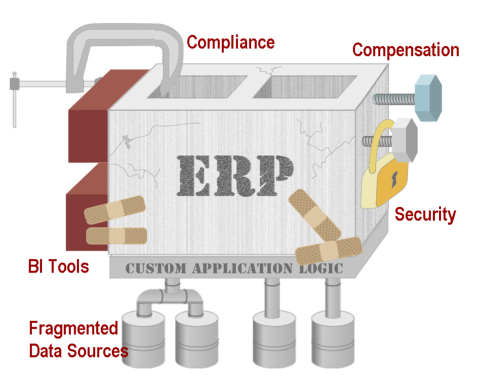Software as a concrete block

One slide that I really enjoyed at last month's SaaScon conference came early in a presentation by Aneel Bhusri of Workday, the SaaS startup that aims to challenge SAP and Oracle's dominance in ERP software.
It casts conventional packaged ERP software in the guise of a concrete block (see picture, below), to which various additional requirements have been grafted on over the years. These add-ons, including security, business intelligence, SOX compliance and compensation management, are all shown bolted or strapped on to the original, highly inflexible, ERP block. The whole assembly looks rather fragile and extremely complex to dismantle — which is exactly the point Bhusri aims to convey.

Workday's challenge is to be ready with a full enough set of features to offer a viable alternative. The company has set out an aggressive product roadmap, which enters its second release next month, when Workday will unveil core financial accounting and reporting for the first time, as well as expanding the feature set of its already released human capital management product.
At the same time it will be demonstrating the agility built into its architecture by upgrading the user interface to take advantage of Adobe Flex. "We're able to use Flex instead of AJAX just by rewriting the front end," technology strategy executive Kelvin Gray told me during a product demo earlier this month. Flex helps Workday build user-defined reporting and analytics into the product as well as adding putting a more graphical interface onto many of the self-service configuration capabilities. One of the more impressive claims made for the product is that it lets managers reorganize teams and reporting lines without constraints. That of course gets even easier if managers can do it by drag-and-drop on an organization chart.
Such capabilities make Workday look much more like putty in user's hands than a monolithic lump of crumbling concrete. The trick, says Gray, is to define the basic constants that define the system, without limiting how users interact with them. "The back-end has to stay in place for 10-15 years. That doesn't change as often as the user interface."